Ever wondered if landing pages can be SEO-optimized without being unnecessarily lengthy and tedious?
This article will offer guidance. Watch out for the 10 steps to do SEO for landing pages like a pro.
The common practice for landing page copywriting and design is KISS: Keep It Simple And Straightforward.
That’s what brands like Apple use — few words but emphasis on images and emotions.
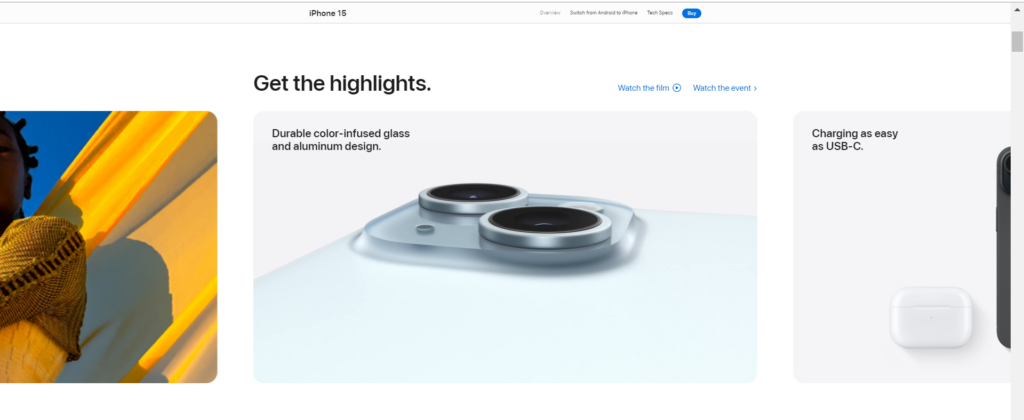
But what if your brand or business is less famous than Apple?
Then, you need SEO (Search Engine Optimization) — in other words, a longer copy. Right?
But won’t that affect the message and conversion of your landing page?
Is SEO landing pages not about lengthy copy? What is it?
More importantly, how can you build SEO-friendly landing pages without losing conversion?
Keep reading to find answers…
What Is an SEO Landing Page?
Let’s break it down for easy comprehension:
SEO landing page = SEO-optimized page + landing page.
In essence, this page is designed to rank high on search engine result pages while generating and converting leads.
Is there any mention of word count in the word count?
No!
Here is why:
SEO landing pages have never been about word count or lengthy copy. Instead, they strategically use targeted keywords and structured content to appease search intent and convert prospects to customers.
In other words, this kind of page only contains the just-fit content — what is needed to convert leads and nothing more.
Furthermore, an SEO landing page will still exhibit the typical elements of a landing page:
- Structure
- Copy
- CTA
- Form
Structure
This element focuses on the design of a landing page. And the idea remains to guide prospects through a journey of awareness through interest in sales.
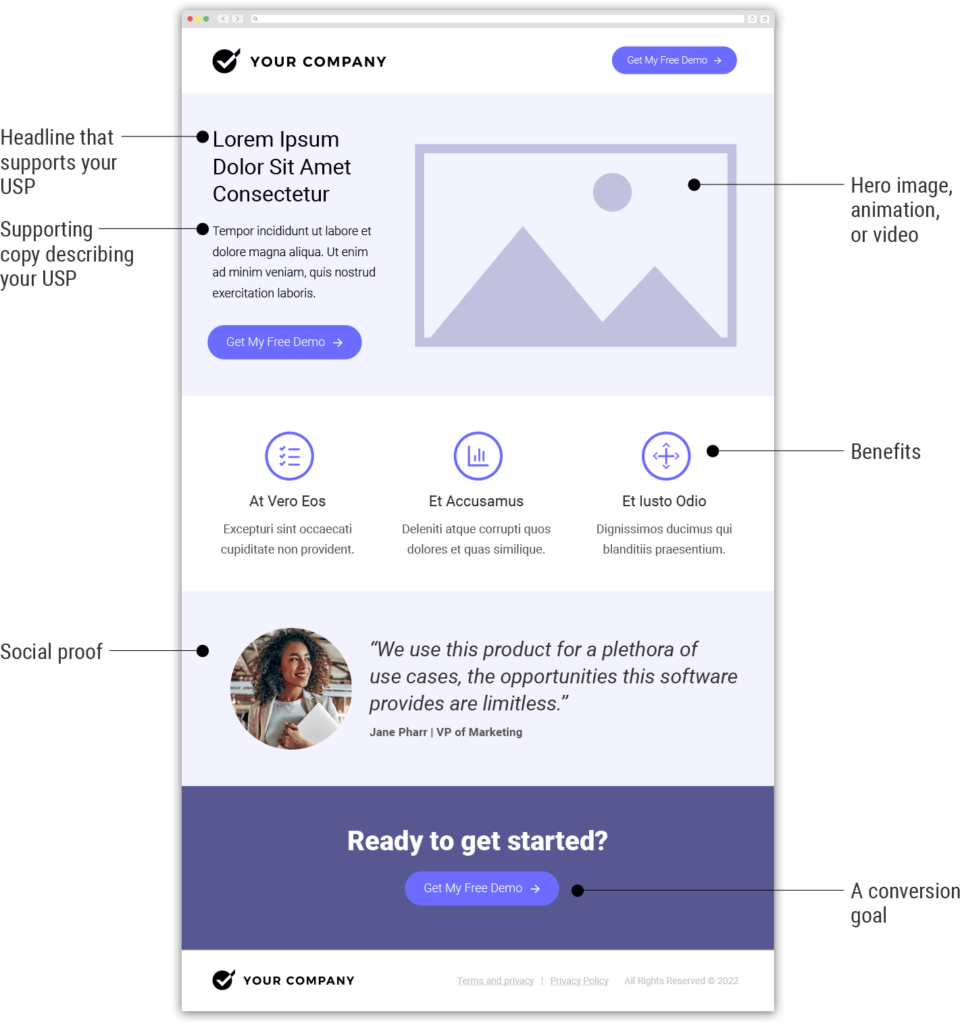
Copy
This element evokes users’ interest to take action through carefully curated words. The idea is to educate people on a problem and show your product/service as the solution.
CTA
You’ve discussed the problem and solution with your copy. CTA (Call To Action) is the prompt that tells your prospects what to do. It is the answer to the “what now” question.
Form
This element lets you collect the email addresses of prospects. Then, you can nurture them via email marketing.
Now, we have covered the basics of an SEO landing page. But what about how to optimize landing pages for search engines?
Follow the steps below.
10 Steps to Optimize SEO Landing Pages
Note: these steps are to be followed as listed to get the best results.
Here’s a quick preview:
- Keyword research
- Satisfy search intent
- Perfect your on-page SEO
- Add & optimize Images and videos
- Optimize page speed and core web vitals
- Add social share buttons
- Edit the page for conciseness
- Publish the landing page on your own domain
- Build backlinks to your landing page
- Ensure that the page is always live
Keyword Research
Like every SEO content type, keyword research is crucial to optimizing landing pages. However, there are a few things to note.
- First, a landing page’s primary aim is to convert visitors.
- In other words, top-of-the-funnel (ToFu) keywords with informational intent are not “good” enough for landing pages. They “educate” rather than “convert.”
- The bottom line is to focus on bottom-of-the-funnel (BoFu) keywords with transactional intent.
So, how can you find these BoFu keywords?
I use any of these two methods:
- Fresh research
- Leverage your competitors
Fresh Research
Tool: Semrush is the easy choice because you can filter for “transactional” keywords.
For this example, I’ll assume you are into the email management and website development business. Let’s do our keyword research already.
- Go to Semrush > Keyword Magic Tool > input your “seed term”
- Change the intent to “transactional” and ensure the search is “phrase match” like this:
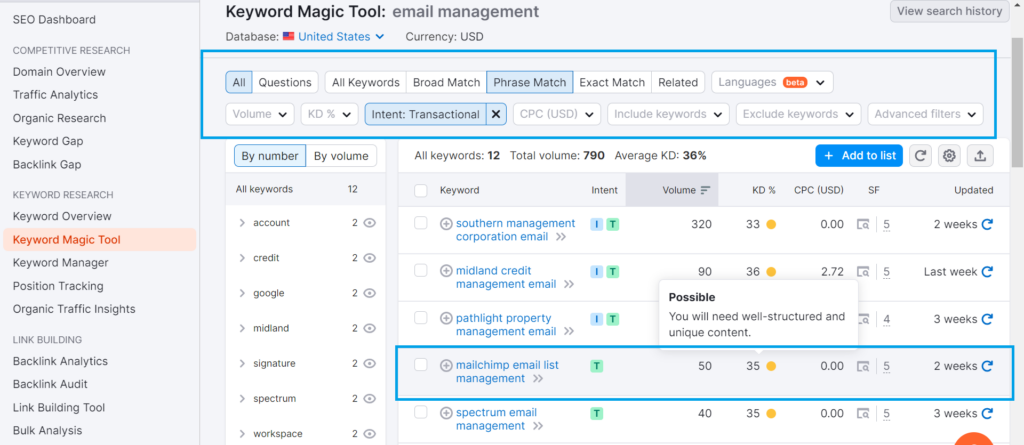
- I’ll pick the keyword “MailChimp email list management” as it looks promising and is relatively easy to rank
Note:
You can twerk the filters even better to find more keywords with little to keyword difficulty.
Leverage Your Competitors
Frankly, the first method is limited. Plus, the target keywords are somewhat untapped. Hence, the reason for the low search traffic.
What if you need a reliable keyword with impressive traffic potential?
Short answer: leverage your competitors! But how?
Tool to use: Ahrefs is the best for robust competitor analysis.
- Go to Ahrefs > Site Explorer > input your competitor domain
📌 Don’t know your competitors?
Go to Ahrefs > Site Explorer > input your domain > organic competitors

- Now, check the left tabs. Look for organic search > organic keywords
- Next, click “keyword filters > keyword > all rules > doesn’t contain” to remove branded keywords from your search like this:

- Check through the results. While at it, avoid “resources,” “blogs,” “glossary,” and other blog-related terms, as they are likely blog posts rather than landing pages. Instead, look for pages with features like this:
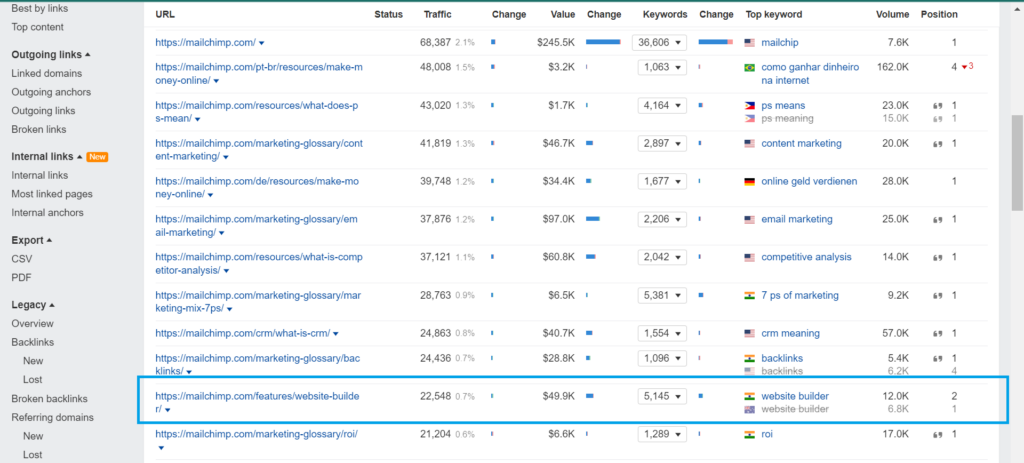
- Click the keyword drop-down button for complementary terms
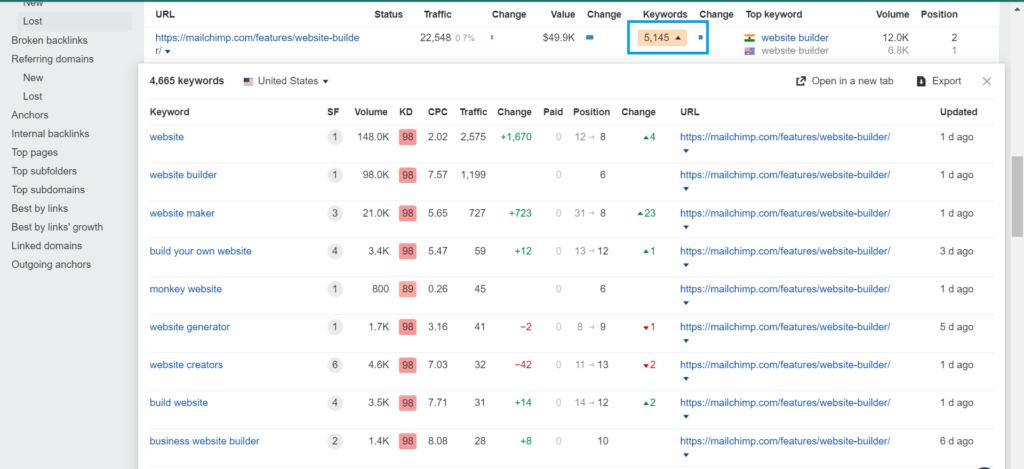
Verdict: Which Method Is Better?
Frankly, I recommend using the two methods together. That is how you can be assured of impressive keywords for your landing page.
That said, I’ll settle for the keyword “website builder” as it has better metrics.
Satisfy Search Intent
Targeting transactional keywords for your landing page is good. But you must ask other critical questions to rank high on search engine results pages. Here are the top 3:
- What questions will the page answer?
- What solutions will you offer to readers?
- Does your landing page meet readers’ needs?
The answer to these questions lies in identifying the search intent behind your keyword.
How can you identify search intent?
The easiest method is to check the structure of top-ranking pages.
In our case, let’s check Mailchimp’s Website Builder page
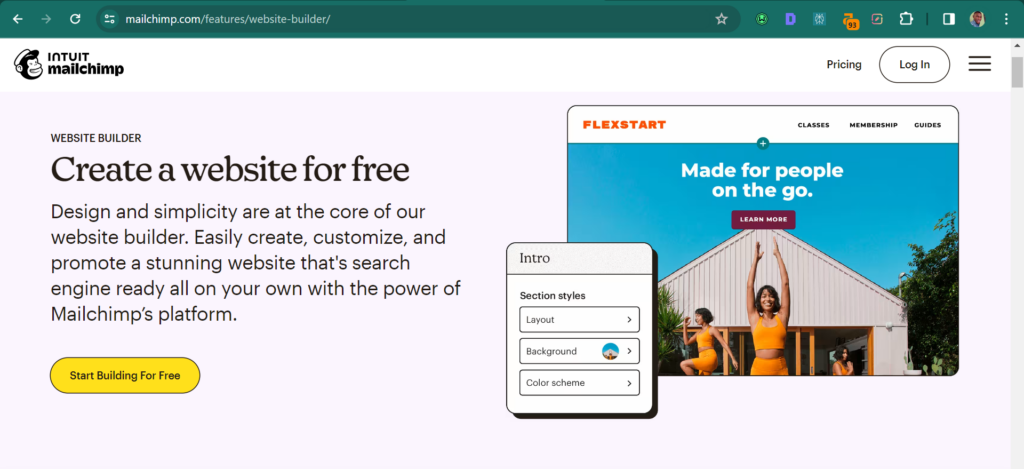
The outline roughly looks like this:
- Summary of the features of the website builder
- Each feature is discussed one after the other, focusing on the benefits for self-starters/small businesses
- Reviews
- Comparison with other web builders
- Link to an educative guide on website building
- FAQs on website building
- Closing Call-To-Action
What can you make out of the outline?
- Your landing page should discuss the core strengths of your offer — the website builder
- More importantly, streamline your landing page to focus on small businesses or self-starters with little or no budget to build a website
Pro tip:
Add a few elements to help your landing page stand out. For our example, short how-to videos and more customer reviews will suffice.
📌 What if you can’t make out the search intent of your competitor’s page by just looking at it?
Go to Ahrefs > Site Explorer > enter the page URL > organic keywords
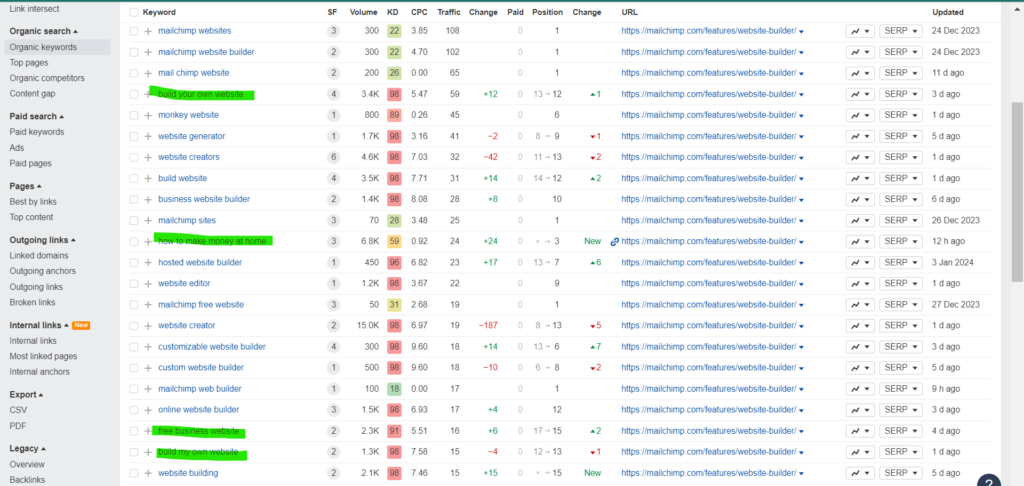
The shaded keywords further prove my earlier suggestions — the target audience and what they expect.
Perfect Your On-Page SEO
Keyword research and search intent are crucial on-page SEO elements. But other elements are just as vital to optimizing your landing page.
Here are 5 such elements that you should perfect:
- Title tag
- Meta description
- Headings
- Internal links
- URL
Title Tag
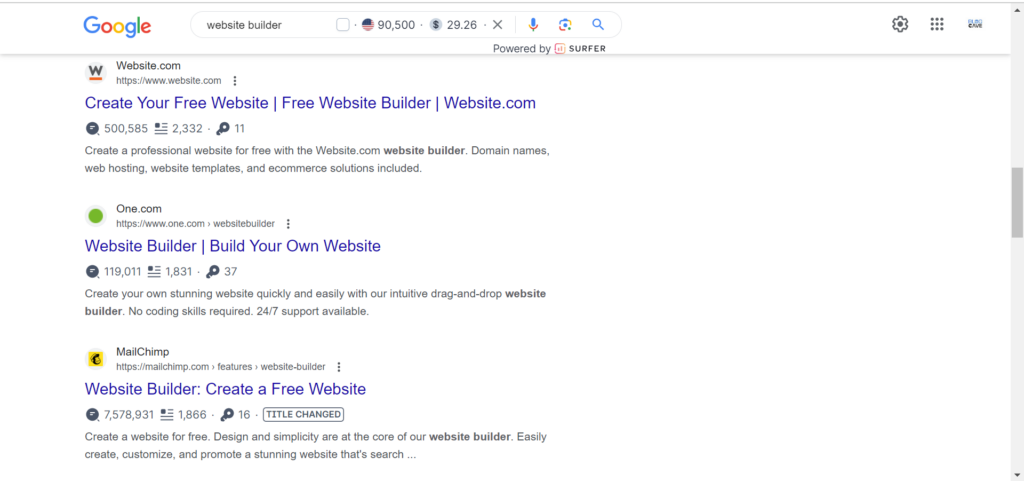
The bold blue texts under the URL are called title tags. They are obviously the first thing your reader will see. So, make them as compelling yet short as possible.
As you can see, ensure your target keyword is placed as much as possible at the start of your title tag.
Meta Description
This is the short text below the title tag. And like earlier, include your keyword in the meta descriptions. Google (and other search engines) will even bolden it to attract searchers’ attention during a search.
Lastly, and most importantly, ensure your meta description is compelling yet straightforward.
Pro tip:
My shortcut to writing meta descriptions for landing pages is to answer the “what” and “for whom” questions. Then, I’ll include my client’s brand name.
Headings
These are marked h1 to h6. But I recommend stopping at h4 to keep your page structure simple.
Ideally, your title tag will be your h1. So, just copy and paste the keyword-optimized text to your h1.
What about h2 – h4?
Use h2 – h4 to simplify ideas and contexts. More importantly, use them to house secondary keywords. Here is an example of how that is done:
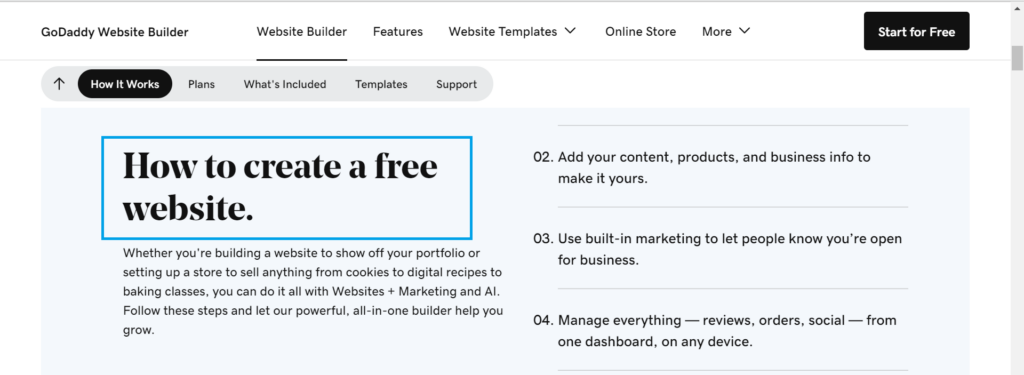
Internal Links
While internal linking helps search engine bots understand your site, don’t overdo it on a landing page. I’ll recommend limiting internal links to a max of 3. And also, when you use them, use exact match anchors.
Further reading: What Is Anchor Text in SEO?
URL
Your landing page URL, like all on-page elements, must contain your keyword. More importantly, it should be simple and precise. The best practice is to maintain not more than 2 hyphens (in other words, 3 crawl depths).
Replicate this hack for your page title.
Add & Optimize Images and Videos
Plastering a long block of text might work for a blog post. It won’t be for landing pages. How so?
Ideally, landing pages are short — meaning there is a limit to how many words you can include.
In essence, landing pages “show, tell, and convince” rather than just “tell.”
For example, if you say your product or tool has a feature, you must back that up with a picture, gif, or short video.
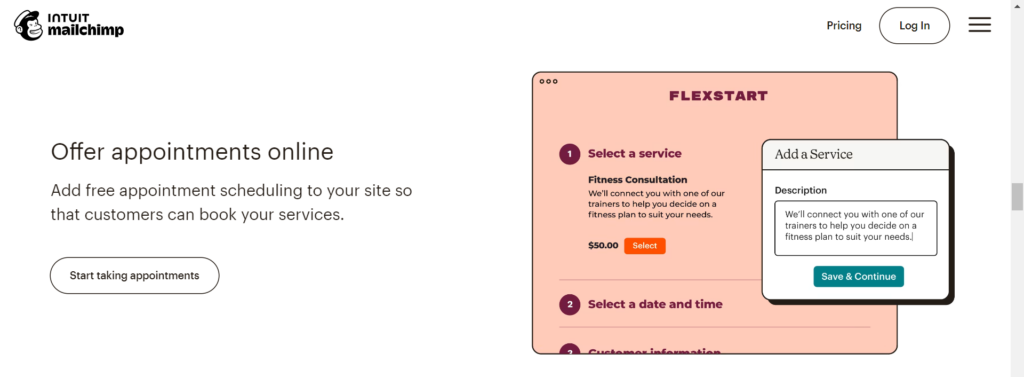
The proof aside, audio-visuals are attention grabbers. It glues users’ attention to your page, increasing your chances of conversion.
Lastly, images and videos come with “alt” tags. You can use these to house keywords and rank for search engine features like image search.
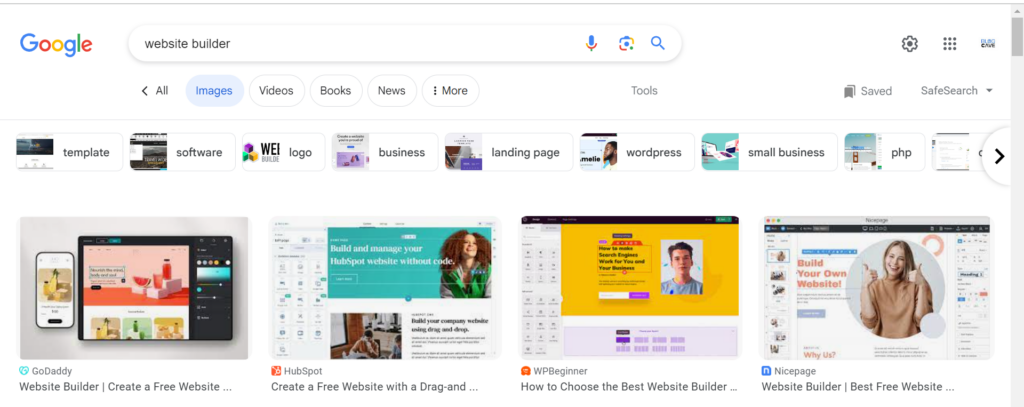
Optimize Page Speed and Core Web Vitals
The chances are that your landing page will load slowly if you add too many heavy images and videos. Unfortunately, this might affect your performance on search engine results.
Worse: user experience will reduce once your page starts lagging.
So, what should you do?
- First, run your landing page through Google PageSpeed Insights and Google Search Console
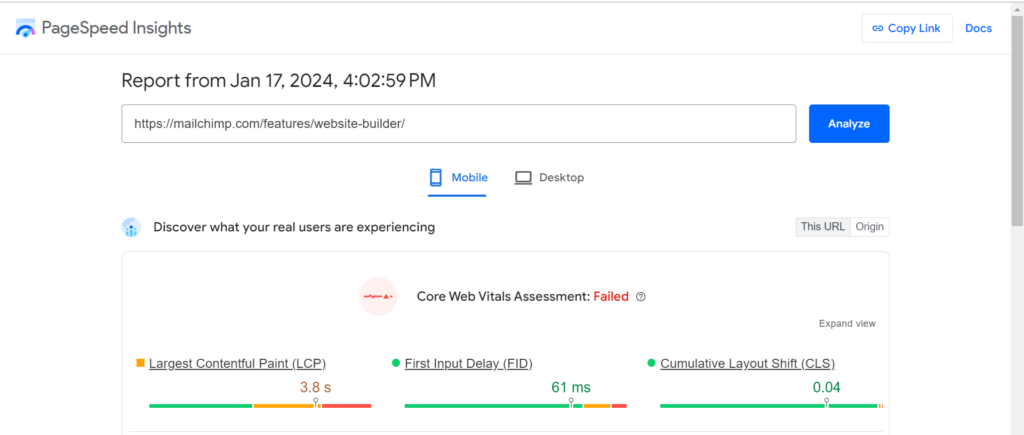
- Alternatively, you can use Ahrefs or Semrush Site Audit tool
- Follow the recommendations from the tools to optimize your landing page’s speed and core web vitals
Pro tip:
Use compression tools to reduce performance-related issues caused by images and videos.
Add Social Share Buttons
While social sharing is said not to be a ranking signal, it remains instrumental to increasing landing page conversion. How?
- Adding social buttons proves that your business/brand is authentic.
- Prospects can check your social media pages to gauge customer feedback and sentiments about your brand.

Beyond the research level, social share buttons increase reach. You can add them to thank you pages. Or, create auto-generated instant shares with captions like “I’m using X.”
Either way, users and customers will spread the news of your products, increasing your reach and boosting your landing page’s conversion.
Ultimately, social shares will help you scale your reach for free. And if you have the budget, you can consider paid advertising on platforms like Facebook and Instagram.
Edit the Page for Conciseness
There is arguably a correlation between long-form content and ranking high on search results — Backlinko.
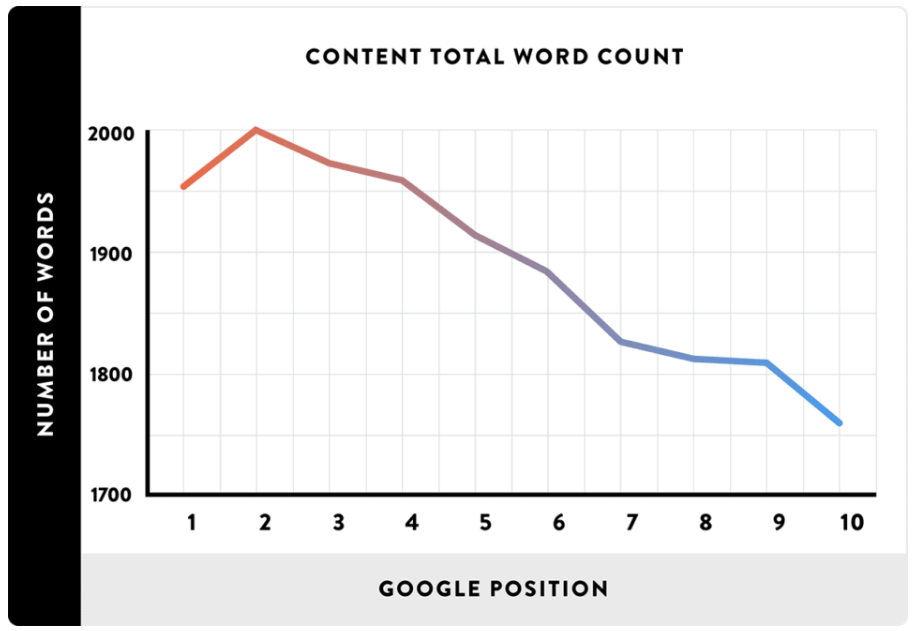
Even at that, don’t worry about such research. They are somewhat skewed towards blog content.
For landing pages, focus on similar landing pages and ask these questions instead:
- How long (words) are your competitors’ landing pages for the target keyword?
- How many words do you need to describe the features of your product/service and convince prospects?
Let the answer guide your word count or the length of your page.
Mind you, the idea that long-form content ranks better is not necessarily about the number of words. It is based on the value the content offers.
Pro tip:
Use collapsible headers/blocks to hide sections like FAQs to simplify your landing pages. Here is an example:

Publish the Landing Page on Your Site
There’s no rule against hosting your landing page on a free, third-party site. You might not have a website yet or couldn’t afford it.
However, there are several issues with publishing on third-party sites.
- First, third-party hosts landing pages as subdomains.
- That will cut off benefits like domain authority and trust
- Ultimately, your search engine rankings efforts will be significantly affected
And say your landing pages perform well despite the issues, you’ll only contribute to another’s domain.
Instead of wasting your effort on someone else’s website, focus on yours. Publish your landing page on your site. And while at it, make the landing page subdirectories instead of subdomains.
This way, your page will benefit from your site’s overall SEO efforts. In other words, you’ll rank faster.
Build Backlinks to Your Landing Page
Creating concise content with relevant keywords isn’t all there is to optimizing landing pages. You still need that upvote from other websites — backlinks.
But it gets tricky. How so?
- Landing pages are “highly” commercial.
- Hence, getting backlinks for them is competitive and time-consuming.
- In short, not all backlink types are effective for landing pages
So, what can you do?
- Target the sources of competitors’ backlinks
- Get listed on “best of” articles
- Join a podcast
- HARO link building
- PR link building
Target the Sources of Competitors’ Backlinks
This link building method is undoubtedly the most effective. The idea is simple: if a website links to a similar landing page, it will likely link to yours.
The only work here is finding qualified sources and avoiding link farms or PBNs.
What should you do?
Good news: I wrote an extensive guide on analyzing competitors’ sites for quality backlinks. Check it out!
Get Listed on “Best Of” Articles
“Best of” articles are curated lists of products or services. Here is an example:
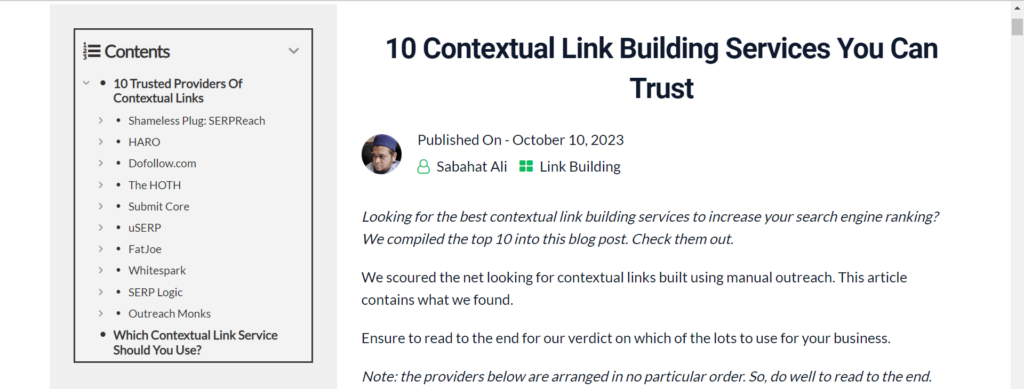
The idea is to get featured with similar service providers or SaaS companies on authority directories. Then, you can funnel the organic traffic to your landing page.
But how will you find the said authority directories?
- Go to Ahrefs > Content Explorer > best [enter seed keyword] > in title
Reminder: our seed keyword is “website builder.”
- Add the “only live” and “published: last 2 months” filter
- Lastly, sort the results by page traffic
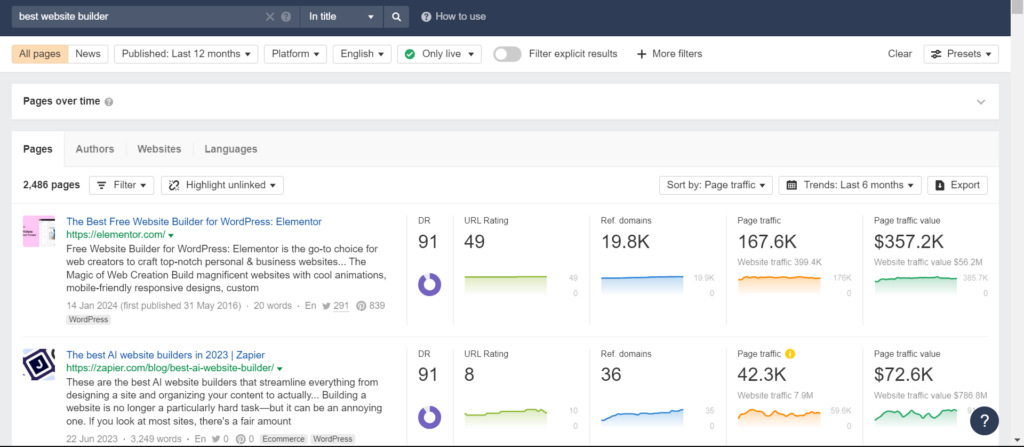
Now, you can use Hunter.io to find the email address of your desired page, send a pitch, and get your backlink.
Join a Podcast
Podcasts are the new rave now. Almost everyone has a podcast now. But don’t get on anyone; reach out to the top voices in your niche. Why?
The audience you seek to convert listens to podcasts. In fact, they are paid subscribers.
Beyond the listeners and subscribers, podcasts come with newsletters. By featuring on the former, you’ll get a backlink from the latter. More importantly, you’ll benefit from the reach and SEO efforts of the websites hosting the podcasts.
HARO Link Building
Like podcast link building, HARO (Help A Reporter Out) involves voicing expert opinions for backlinks. The only difference is those on the receiving end and the platform used.
You’ll work with journalists from reputable media/news sites in HARO. How so?
- You’ll register to be a source on HARO
- Send answers to journalist queries and get backlinks
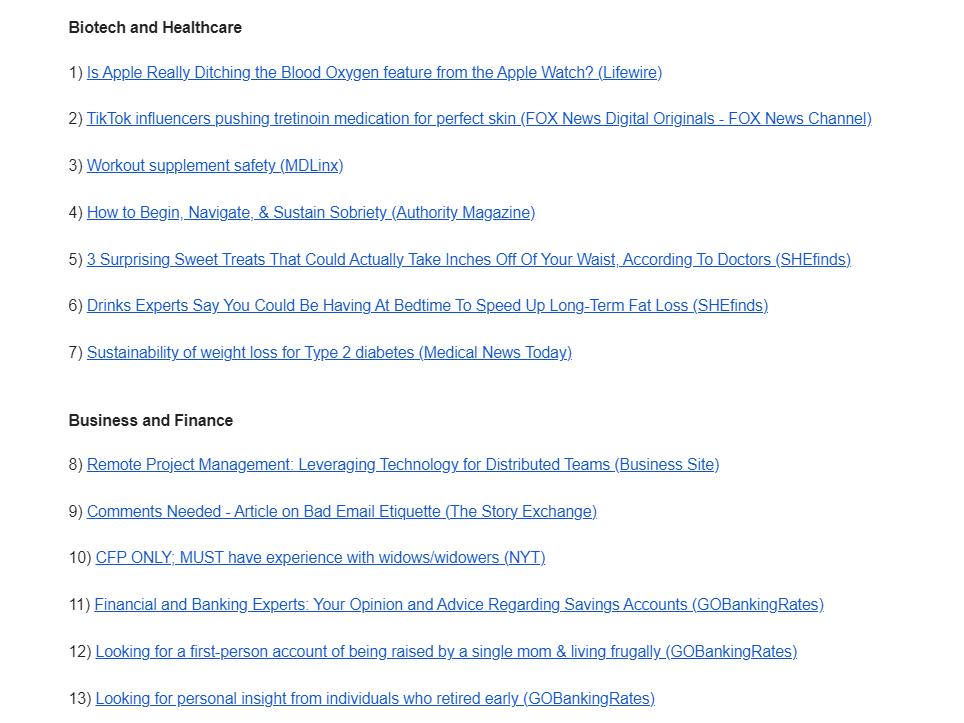
Further reading: How to Use HARO for Link Building
PR Link Building
This link building technique is similar to HARO in the sense that you’ll be working with journalists. However, it is not always directly unlike in HARO.
So, how do PR backlinks work?
- Host a newsworthy event — this could be an open day or sponsoring a local event in your community
- Launch targeted outreach out to media houses about the newsworthy event for backlinks
The idea is that getting your news posted on a site will create a ripple effect as other media houses will pick up the story.
Further reading: What Are PR Backlinks?
Ensure That the Page Is Always Live
Understandably, you will have seasonal sales like Black Friday with a dedicated landing page. And such a page will likely be ineffective after Cyber Monday, right?
The logical thing is to pull it down. Isn’t it?
I beg to differ!
Don’t delete any of your landing pages, whether for seasonal projects, long-term projects, or expired functions. Why?
- Deleting a page you’ll likely need again will cost you steps 1 – 9.
- Keeping the page live reduces stress. Plus, you only have to continue from where you stopped.
- More importantly, the seemingly ineffective page will keep ranking and drawing in traffic.
- In the case of dead projects/expired functions, redirect the pages.
Still not getting how to optimize your landing page for SEO?
Maybe the steps are unclear, or do you need to see examples?
Either way, I curated a list of some of the best SEO landing pages you can learn from. Check them out below.
3 Examples of SEO Landing Pages
Here’s a quick breakdown:
- Semrush’s Keyword Magic Tool
- Ahrefs’ Backlink Checker
- HubSpot’s Email Signature Generator
Semrush’s Keyword Magic Tool
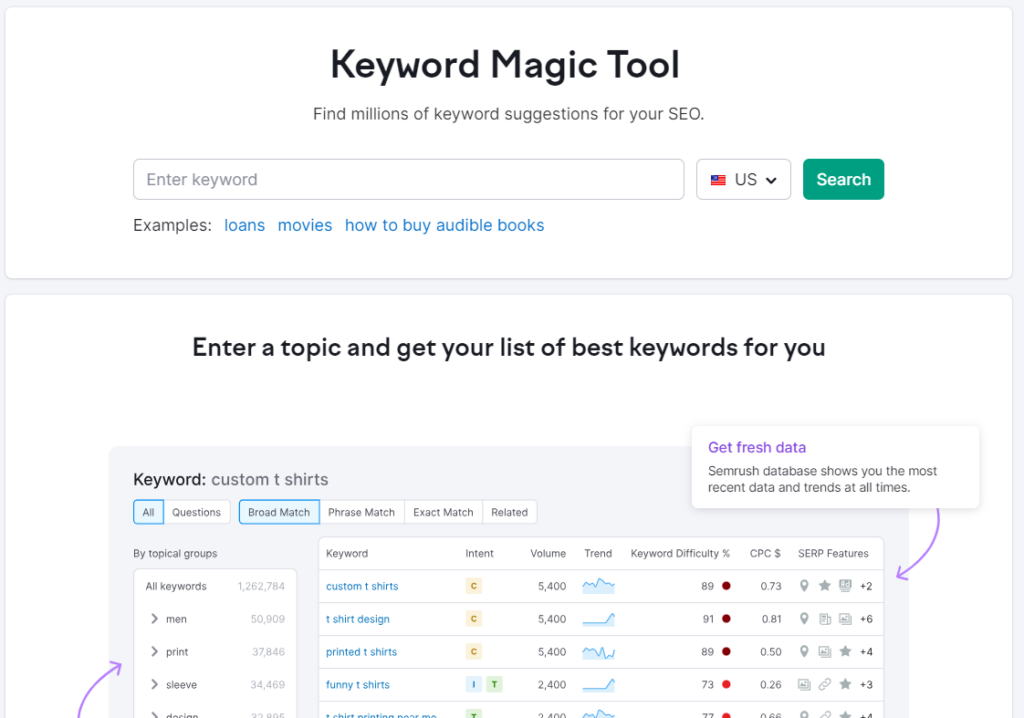
This landing page follows all the steps discussed — everything from the on-page and off-page to FAQs are used. And I love the KISS.
Also, the simple how-to infographic fits perfectly into the copy.
However, there are no reviews or testimonials. Nonetheless, it is still a great SEO landing page.
Ahrefs’ Backlink Checker
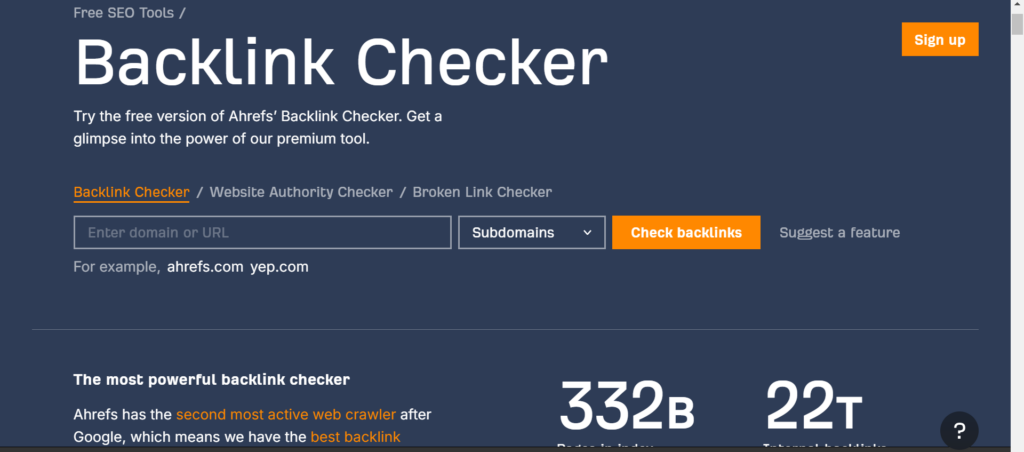
This landing page has a lengthy copy, yet it reads smoothly with no fluff. Hence, it is a perfect example if your product or service requires more words to convince and convert prospects.
Also, I love the numbers added to boost credibility.
Lastly, and most importantly, the floating CTA “sign up” is ingenious.
HubSpot’s Email Signature Generator
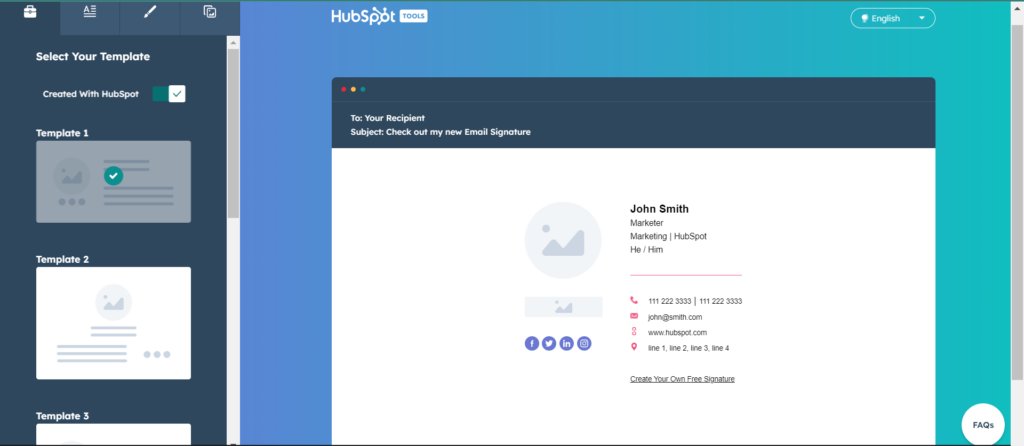
This landing page is less copy and more hands-on. In fact, you’ll dive straight into using the generator.
So, where are the keywords?
In the FAQ — very creative!
This approach also works. But you must get several backlinks to compete with top brands for the same keyword.
Summary: SEO-Optimized Landing Pages Are More Than Lengthy Copy
An SEO landing is never about more words. It is more — meets search intent, has perfect on-page SEO, and has high-quality backlinks.
All these little details ensure you don’t only rank high on search results. They are also instrumental in converting leads. That is the essence of SEO landing pages.
FAQs
How Do I Choose Keywords for My Landing Page?
There are two ways to choose keywords for a landing page.
- First, you can start fresh research using tools like Semrush to find transactional keywords around your seed term.
- Second, explore your competitors’ landing pages. Check what they are ranking for that you can adopt.
Ultimately, I recommend combining both methods to get effective keywords for your landing page.
How Many Keywords Should I Use in a Landing Page?
Frankly, there is no rule. However, I’ll recommend you stick to one primary keyword.
You can target a few secondary terms in your h2 – h4.
How Long Should an SEO Landing Page Be?
Short answer: your SEO landing page should be as long as possible to convince and convert prospects to customers.
The shortcut is to check the length of your competitors’ landing pages. But even then, don’t focus too much on word count.

